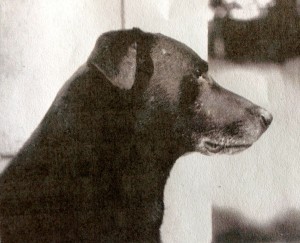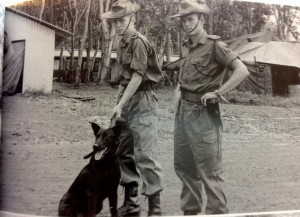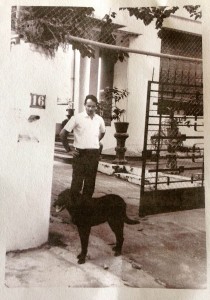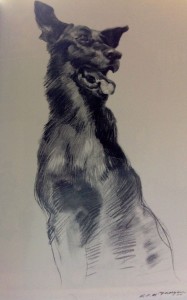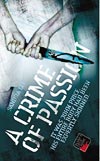A few weeks ago at the State Library of New South Wales chance dealt me a top hand and I met a couple who had just bought a book about a dog rescued by Australian soldiers during the First World War and secretly repatriated the scrappy mutt to Australia against military orders.
As they were talking, I mentioned my book a on modern-day hero hound from the war on terror in Afghanistan, Saving Private Sarbi.
The man, Geoffrey White, said he knew of Sarbi, a highly skilled Explosives Detection Dog in the Australian Army (now retired) and explained he had a historical connection with military working dogs from our fine Army during the Vietnam War when our Diggers’ used tracker and guard dogs.
Geoffrey (pictured below outside his home in Vietnam) was the First Secretary at the Australian Embassy in Saigon. He took ownership of the maverick black mutt named Caesar in 1971, after he was retired from active service due to burn out from three hard years of duty during which he repeatedly saved the lives of his handler and and fellow Diggers. Caesar was one of the first two Australian four-legged warriors sent to the Vietnam war to see active service. Unlike our current canine corps who have served in Iraq, Afghanistan and East Timor, their pooch-troop predecessors from the 1960s and 1970s never came home.
As I write in Saving Private Sarbi, strict quarantine regulations in Australia prohibited the dogs’ return and they were found new homes upon retirement. Caesar’s handler, Peter Haran, had enlisted in the army at the age of 18 and Caesar was his tracker dog when first deployed to Vietnam. Haran was gutted when he returned to Australia after his tour of duty was over without his beloved four-legged best mate who was passed to the incoming rotation of troops.
Here’s an excerpt from my book on the start of the Australian Army’s official working dogs scheme:
“Infantry patrol dogs and tracker dogs were used in the Korean War. A patrol dog scouted ahead of the troop to find enemy positions and weapons and, once detected, a tracker dog, working on a leash in tandem with its handler, searched through the enemy positions, to help neutralise the threat. The teams were so successful that it made sense at war’s end to formalise the program in Australia and in subsequent years dog teams were deployed as offensive and tactical tools to new battlefields in Borneo and again during the Malayan Emergency.
“The Tracking Wing officially was established in 1966 at the School of Infantry in Ingleburn in Sydney with a solitary mongrel liberated from death row for the princely sum of $3. The first dogs to be enlisted into what were then known as Combat Tracking Teams were named after Roman emperors and given lofty titles including, Cassius, Marcus, Caesar and Tiber. The last three had the distinction of being the longest serving of the eleven Australian dogs first sent to the Vietnam War in 1967.
“Once trained, these freshmen trackers were deployed to infantry battalions to track fleeing enemy soldiers through impenetrable jungle woven thick with foliage. Like most of their canine predecessors in the First and Second World Wars, none ever made it home.
“Australia’s strict quarantine regulations prevented the return of the hero dogs, which was utterly soul destroying for the men with whom they had bonded and whose lives they helped save. The diggers took solace knowing their mates had found new homes in embassies or with civilians but they never forgot their best mates.”
Caesar was rescued from a Sydney dog pound for the princely sum of $3 and trained for tracking the enemy in Vietnam. He was regarded by the military brass as one of the very best tracker dogs trained, if not the best. Haran writes in his book that his life on active duty in a war-zone “depended on a wet nose and the uncanny animal instinct of a black Labrador-kelpie cross smart arse called Caesar.”
He was first posted to Vietnam in 1967 with Haran (pictured at left with Caesar in Vietnam) as part of the 2nd Royal Australian Regiment (RAR) combat tracking team out of Brisbane, and was one of the first two dogs deployed to the war, the other being a pure-bred black Labrador retriever named Marcus.
Caesar, who looks a lot like Sarbi, was then handed over to 4RAR. As Haran writes in his top book, Trackers, The Untold Story of the Australian Dogs of War, Caesar then served with other handlers in 5RAR and 9RAR in 1969 and 1970. “The day I left him there broke my heart,” he writes.
Caesar was retired in July 1970 and went to live with the defence attache at the British Embassy, but he was recalled to England and had to find a new home for brave mutt who had served his country and allies so well.
Enter Geoffrey White, who was then living in a duplex on Phan Dinh Phung Street in the heart of Saigon. In September 1971, Geoffrey happily accepted Caesar, then eight and a half years old.
“My family joined me in late February 1972,” says Geoffrey, who later became the Counsellor for the Australian Embassy in Saigon. “Later when the Australians pulled out completely I was allocated the General’s residence on Alexandre de Rhodes – one of only two French names used on the streets. This house was a little too close for comfort to the Independence Palace where President Thieu lived.
“I used to exercise Caesar in a nearby park and each year took him out to the US Air Force base at Tan Son Nhut and put him through the dog dip. We also took him to Vung Tau where we all went into the sea together.
“We always knew we were holding a warrior and a decorated one at that!” Geoffrey says.
He certainly was.
Casear, D6N03, was the only one of the 11 dogs serving with the Australian Army to have his portrait done by the official war artist in Vietnam, Ken McFayden. The artist, who painted Caesar in 1968, has captured his maverick attitude perfectly (see left).
Once retired, the hero hound lived a happy and healthy life with Geoffrey, his wife, Sally, and their four children for two years.
